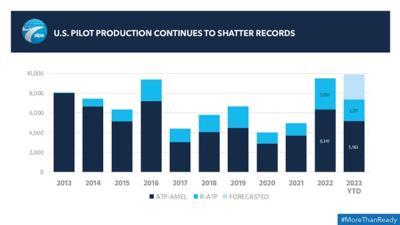Pilot Shortage Narrative Called Into Question
As special interests in Washington, Brussels, and Luxembourg persist in vehemently asserting and loudly lamenting a global pilot shortage, the Federal Aviation Administration has released verifiable data clearly indicating the United States is producing record numbers of pilots.

The last 12-months have seen the FAA certify a total of 10,191 new Airline Transport Pilots (ATP). In August 2023 alone, upwards of 1,200 new ATPs were vetted and written gleaming new tickets—the largest monthly number in history.
Overall, the U.S.’s population of ATP-certificate-holders exceeds its pre-COVID number by more than 6,500 aviators—so states the Department of Transportation and airline filings with the Securities and Exchange Commission (SEC).
Addressing the disparity between concrete fact and guesswork, ALPA president Captain Jason Ambrosi set forth: “This data-centered reality check comes at a critical time for anyone who cares about the safety of our skies because Congress is poised to introduce more risk into America’s aviation system, the safest in the world.”
Captain Ambrosi added: “The special interests pushing these changes hang their hat on the false premise that America isn’t producing enough pilots to meet demand, but the FAA’s data proves their claim is flat-out wrong. In fact, the United States is shattering records when it comes to pilot production.”

Currently, a number of special interests—primarily ultra-low-cost airlines the likes of Republic and SkyWest—are lobbying Congress to make changes to U.S. aviation safety laws, including weakening pilot-training requirements and raising the mandatory retirement age. Since passage of the Airline Safety and Federal Aviation Administration Extension Act of 2010, the United States has seen a 99.8-percent reduction in airline passenger fatalities.
“Pilot production is up, the passenger fatality rate is down, and our skies are the safest in the world,” Ambrosi declared. “The current production of pilots is outpacing U.S. airline hiring needs, so there’s no need to change a law that has been proven to save lives.”
ALPA’s position—as framed by Captain Ambrosi—is allegedly substantiated by the fact the union, by arguing against proposed measures to lower pilot certification standards for purpose of hastily filling voids in air-crew staffing, subtracts substantially from its own membership roster and bottom-line.

Should special-interest groups prevail in pressuring lawmakers to lower pilot training requirements and experience standards, such legislation would impact commuter/regional air-carriers primarily—carriers populated by lower-time, lower-experience pilots working to build flight-time and flight-deck acumen in hopes of moving on to major airlines.
More so than most, certainly more so than Congress, ALPA’s leadership understands the devastating, industry-wide impact wrought by high-profile aircraft accidents the likes of Colgan Air Flight 3407, American Eagle Flight 4184, CommutAir Flight 4821, Atlantic Southeast Airlines Flight 2254, and Comair Flight 3272—all of which befell commuter/regional air-carriers and were reported to have been caused by the errors of relatively low-time, low-experience pilots.
Founded in 1931 and representing over 74,000 pilots in the employs of 42 U.S. and Canadian airlines, the Air Line Pilots Association, International (ALPA) is the world’s largest and most influential pilot union.
 ANN's Daily Aero-Term (12.19.25): Ultrahigh Frequency (UHF)
ANN's Daily Aero-Term (12.19.25): Ultrahigh Frequency (UHF) NTSB Prelim: Cirrus Design Corp SR22T
NTSB Prelim: Cirrus Design Corp SR22T Classic Aero-TV: The Red Tail Project--Carrying the Torch of the Tuskegee Airmen
Classic Aero-TV: The Red Tail Project--Carrying the Torch of the Tuskegee Airmen Aero-News: Quote of the Day (12.19.25)
Aero-News: Quote of the Day (12.19.25) Airborne 12.17.25: Skydiver Hooks Tail, Cooper Rotax Mount, NTSB v NDAA
Airborne 12.17.25: Skydiver Hooks Tail, Cooper Rotax Mount, NTSB v NDAA





